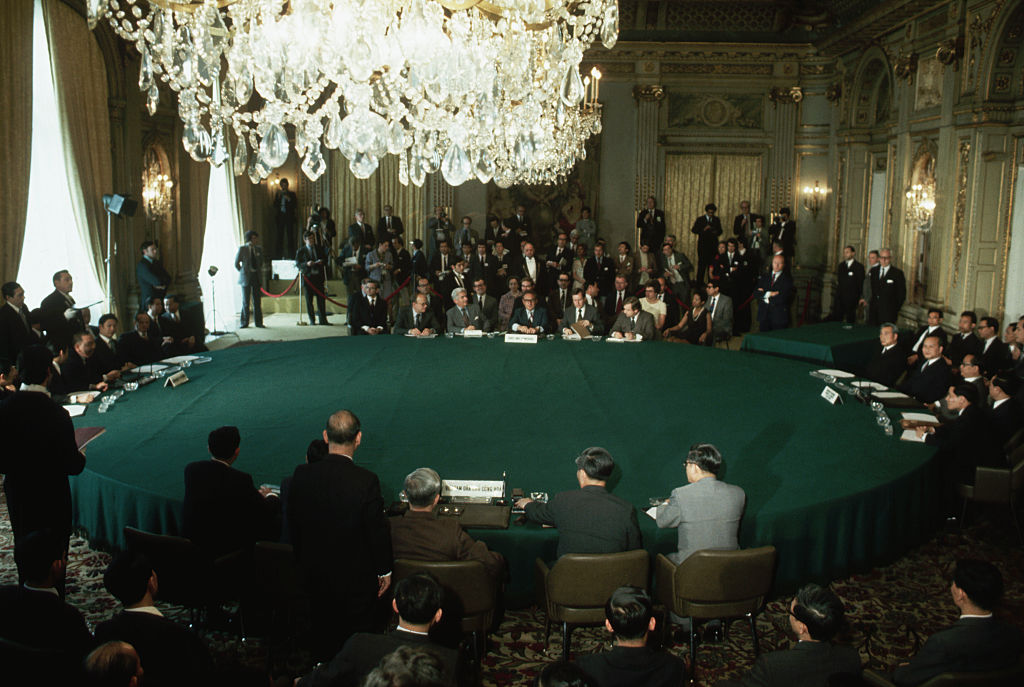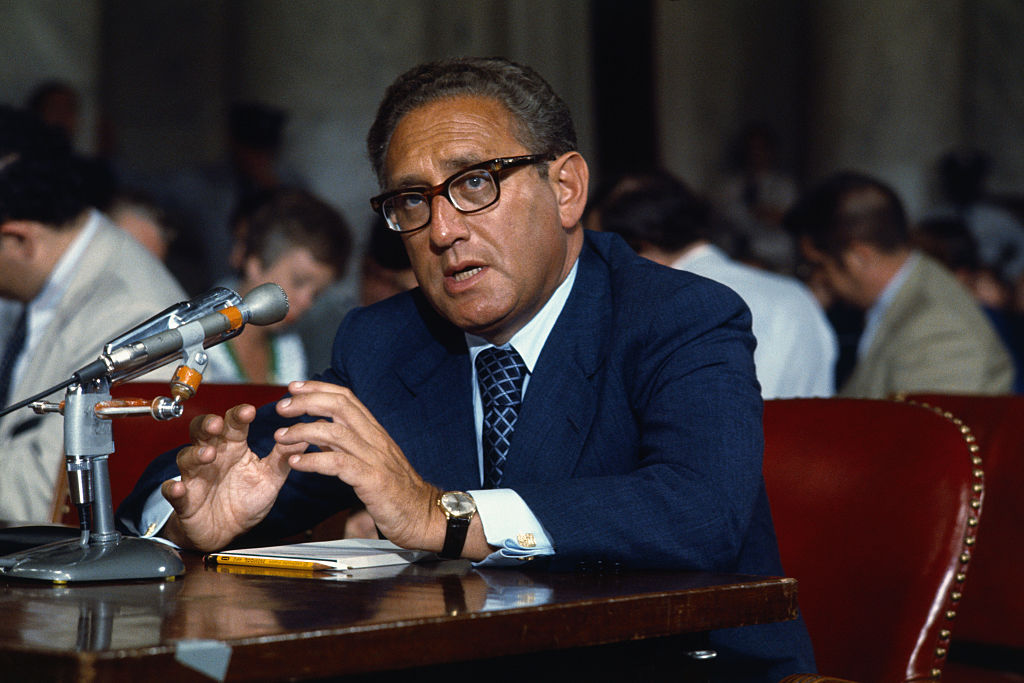When Ronald Reagan ran for president of the United States in 1980, he put “peace through strength” at the heart of his foreign policy vision. That October, one month before the election, the then-governor of California used a television address to lay out his “Strategy for Peace in the 1980s.” In his interpretation, “peace is made by the fact of strength – economic, military, and strategic,” Reagan said, and “peace is lost when such strength disappears or – just as bad – is seen by an adversary as disappearing.”
It was not a new idea even then. Barry Goldwater had talked of the “Republican party, this party of peace through strength” during his (failed) 1964 presidential run. Before him, the concept had been popularised as the title for a 1953 book on Bernard Baruch – the great US financier and statesman who helped steer US economic mobilisation and industrial war production in both world wars. And beyond that, the lineage of “peace through strength” stretches through the Founding Fathers all the way back to the Romans and their si vis pacem, para bellum mantra.
Reagan was well aware of just how hackneyed the formula had become. It is simple, powerful, and common-sensical: perfect for sounding strong and smart on statecraft to voters. Indeed, in that October 1980 TV speech he pointedly acknowledged that “we have heard the phrase ‘peace through strength’ so often, its meaning has become blurred through overuse.” But, unlike many of his predecessors, he then proceeded to build a complex and effective strategy around it, and gave it a new lease of life. In office, Reagan gave real substance and depth to “peace through strength,” pursuing both a massive military build-up and arms control negotiations with the Soviets at the same time. This won the Cold War.
In our times we hear a great deal about the old phrase once again. Donald Trump explicitly embraced it on the campaign trail in September 2016, beginning his Philadelphia speech by saying that, “I am here to talk about three crucial words that should be at the centre of our foreign policy: Peace Through Strength.” The Trump Doctrine (previously discussed in these pages) that came to characterise his presidency emphasised strength with certain Realpolitik overtones. Peace was left to be defined by the avoidance of new wars – a not inconsiderable achievement, but falling short of solving any ongoing conflict.
Should Trump regain the White House, the “three crucial words” are set to provide the core framing of US national security policy one more time. There is little doubt about this, judging by the landmark article published this June in Foreign Affairs by Trump’s last (and likely future) national security adviser, Robert O’Brien, titled rather clearly, “The Return of Peace Through Strength.” But the piece opens with the familiar Roman exhortation about preparing for war, and hardly strays from its main focus on hard power and rebuilding the US military.
The contemporary iteration of “peace through strength” is very much about ensuring strength and too little about achieving peace. The phrase has worn thin, again, and stands for little more than a way to signal a robust position on national defence. It is due for a Reagan-style revamp that asks the hard questions about exactly how peace can be restored to our burning world – how can we move from containing the fires, to putting them out. That a strong military must be the foundation of an effective foreign policy is widely agreed; what to do with it – less so.
With crises, threats and risks on multiple fronts from Ukraine to Israel, the Red Sea or Taiwan, the priority is either to prevent the situation from escalating further, or – at the level of global policy – to ensure we remain “competitive” against the Revisionist Axis of China, Russia, Iran and North Korea and deny them their objective of reshaping world affairs in their image.
But we rarely step back and consider that Western strategy has no endpoint at the moment. It is an open-ended struggle with the authoritarians, not a path towards some kind of conclusion. How exactly do we expect to “defeat” China or Russia in the future and remove them as threats – and what does that even mean? Are we simply locked forever in a world of grey zone warfare, cyber-attacks, trade wars, proxy wars, info-wars, sponsored terrorism etc – at exorbitant costs, teetering on the edge of global conflagration?
For much of the Cold War, America broadly followed the Containment strategy whose outlines were articulated by George Kennan as early as 1946 in his famous Long Telegram from Moscow and then in his landmark 1947 Foreign Affairs article under the pseudonym of “X”. He foresaw that Soviet Communism would collapse on its own in the long run, if the free world stood firm, and he was right. But with Reagan, US policy took a truly novel turn when he decided that the USSR’s power could be broken for good, and hastened the end by adding diplomacy to the mix.
In our case, we are nowhere close to a consensus on today’s equivalent of Containment, or any kind of general strategic approach to the geopolitical problems of this era. Western nations got startled by the comparatively swift turn in world events from around 2013/2014 onwards and scrambled to react, struggling to awaken from their “end of history” slumber. Ten years on, Western policy is still, effectively, an extension of those improvised responses – from NATO’s “enhanced forward presence” in Eastern Europe to America’s “pivot to Asia,” begun under the Obama administration to balance the “rise of China” which had suddenly panicked everyone at the turn of the decade.
The US and its allies are trying to keep the lid on these various flashpoints, but there is hardly any serious discussion of how to return a greater measure of peace to global affairs, even if that may be a very long-term project. It is not just strategic myopia and the “fire-fighting” syndrome (that distracts decision-makers from seeing the broader picture). But there is an increasingly high, morally-driven societal penalty to even raising the question about how to reduce global tensions and work towards a larger settlement of the key outstanding issues (which are all interlinked). Any such attempts are instantly dismissed with the old slur: “appeasement.”
Had Reagan taken the same attitude, focusing only on the military build-up while leaving arms control and wider negotiations with Gorbachev out of his “peace through strength” policy, the Soviets might not have folded for many years – or at all, thus following the Chinese model.
World statesmen’s task for the rest of this decade is to make more room for diplomacy. We have seen that strength is necessary but not sufficient to keep the peace, let alone to restore it when it is lost. Russia gambled in Ukraine despite overwhelming Western aggregate strength which could clearly mobilise behind Kyiv, as it since has; Hamas did the same against the Israeli war machine on October 7th; and the Houthis’ brazen defiance likewise stands against the might of Western naval power. Look in history and you will find many similar instances of the weaker taking on the stronger – where “deterrence” (that false god of today’s “strategic community”) should have worked but it didn’t.
What all our foes now understand much better than us is that the rules and therefore odds of aggression have changed in the 21st century. Western nations have lost their technological edge in military affairs, their armies have shrunk, and the information revolution has made them vulnerable at home. “Hearts and minds” are now being won for the enemy, among our own people.
In short, we are well past the point in history where hard power could be relied on to provide clear solutions to security and foreign policy problems. There is no sword that can cut the Gordian knot of strategic challenges anymore; the problem is more akin to disentangling ourselves from a sticky web while keeping the spider at bay. Adversaries must be outsmarted at the strategic level, over time – not just outgunned. For this, strength is certainly necessary, but not sufficient. We also need diplomacy.
Gabriel Elefteriu is deputy director at the Council on Geostrategy in London and a fellow at Yorktown Institute in Washington, D.C.






The West can still get things done: The ramp-up in Allied ammo production is a reminder of our inherent strength